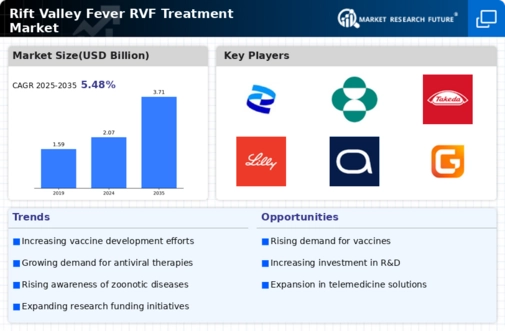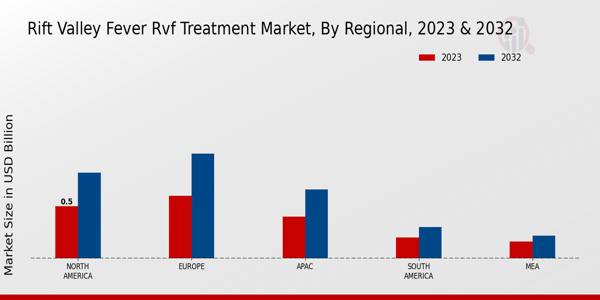Market Growth Projections
The Global Rift Valley Fever RVF Treatment Market Industry is projected to experience substantial growth over the coming years. With a market value expected to reach 2.07 USD Billion by 2024 and 3.71 USD Billion by 2035, the industry is poised for a robust expansion. The anticipated CAGR of 5.46% from 2025 to 2035 reflects the increasing demand for effective treatments and preventive measures against RVF. This growth trajectory is influenced by various factors, including advancements in medical research, government initiatives, and rising awareness about the disease. As the market evolves, stakeholders are likely to explore innovative solutions to address the challenges posed by RVF.
Rising Awareness and Education
Rising awareness and education about Rift Valley Fever among healthcare professionals and the public are crucial for the Global Rift Valley Fever RVF Treatment Market Industry. Increased understanding of the disease's transmission, symptoms, and treatment options can lead to earlier diagnosis and intervention, ultimately reducing morbidity and mortality rates. Public health campaigns and educational programs are being implemented in endemic regions to inform communities about preventive measures. This heightened awareness is likely to drive demand for effective treatments and contribute to market growth, as more individuals seek medical assistance upon experiencing symptoms.
Global Trade and Travel Dynamics
The dynamics of global trade and travel significantly influence the Global Rift Valley Fever RVF Treatment Market Industry. As international travel increases, the risk of RVF spreading to non-endemic regions rises, prompting governments and health organizations to enhance their preparedness and response strategies. This situation creates a demand for effective treatments and vaccines, as travelers and local populations become more susceptible to the disease. Consequently, the market is expected to expand as stakeholders recognize the need for robust healthcare solutions to address the potential threats posed by RVF in a globalized world.
Government Initiatives and Funding
Government initiatives and funding aimed at combating Rift Valley Fever are vital drivers for the Global Rift Valley Fever RVF Treatment Market Industry. Various governments are increasingly recognizing the economic and health impacts of RVF, leading to increased investment in research, surveillance, and treatment options. For example, funding for vaccine research and public health campaigns has been prioritized in affected regions. This proactive approach not only aims to reduce the incidence of RVF but also supports the growth of the treatment market. As a result, the market is projected to reach 3.71 USD Billion by 2035, reflecting the positive impact of these initiatives.
Advancements in Vaccine Development
Recent advancements in vaccine development for Rift Valley Fever are poised to significantly impact the Global Rift Valley Fever RVF Treatment Market Industry. Innovative research has led to the creation of more effective and safer vaccines, which are crucial in controlling outbreaks. For instance, the development of live-attenuated vaccines has shown promise in providing immunity without causing disease. As these vaccines become available, they are expected to enhance public health responses and reduce the economic burden associated with RVF outbreaks. The market is anticipated to grow at a CAGR of 5.46% from 2025 to 2035, driven by these advancements.
Increasing Incidence of Rift Valley Fever
The rising incidence of Rift Valley Fever (RVF) globally is a primary driver for the Global Rift Valley Fever RVF Treatment Market Industry. As climate change and environmental factors contribute to the spread of the disease, outbreaks have been reported in various regions, particularly in Africa and parts of the Middle East. This increase in cases necessitates the development and distribution of effective treatments, thereby propelling market growth. The Global Rift Valley Fever RVF Treatment Market is projected to reach 2.07 USD Billion by 2024, reflecting the urgent need for medical interventions to combat this zoonotic disease.















